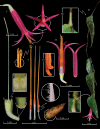Ceratostema limonensis (Ericaceae), a new species from the Province of Morona-Santiago, Ecuador
- PMID: 41017859
- PMCID: PMC12461215
- DOI: 10.3897/phytokeys.263.159645
Ceratostema limonensis (Ericaceae), a new species from the Province of Morona-Santiago, Ecuador
Abstract
A new species of Ceratostema (Vaccinieae) from south-eastern Ecuador is here described and illustrated. Ceratostema limonensis is distinguished by the singular, subflexuous young branches. The new species is compared to the morphologically similar C. gualaquizensis, which differs by the subterete, longer rachis and shorter corollas with narrower monochromatic corolla lobes. A brief history of the species from the tribe Vaccinieae in Ecuador is provided. Further taxonomic discussions, distribution and conservation status for the new species are provided in this paper.
Keywords: Amazon; Andes; premontane forest; rainforest; taxonomy.
Marco M. Jiménez, Gabriel A. Iturralde, Diego Gutiérrez del Pozo, Nadia Lapo-González, J. R. Kuethe, Henry X. Garzón-Suárez.
Conflict of interest statement
The authors have declared that no competing interests exist.
Figures




References
-
- Beentje H. (2012) The Kew Plant Glossary: An Illustrated Dictionary of Plant Terms. Royal Botanic Gardens, Kew. Kew Publishing, 1–184.
-
- Cornejo X, Luteyn JL. (2024) Three new epiphytic species and a new variety in Ceratostema (Ericaceae: Vaccinieae) from Southeastern Ecuador. Journal of the Botanical Research Institute of Texas 18(2): 321–332. 10.17348/jbrit.v18.i2.1369 - DOI
-
- Cornejo X, Tello-Hidalgo G, Luteyn JL. (2024) Ceratostema loucianae and Disterigma chriscanadayi (Ericaceae: Vaccinieae)—new epiphytic species from eastern Ecuador. Journal of the Botanical Research Institute of Texas 18(1): 87–93. 10.17348/jbrit.v18.i1.1340 - DOI
-
- Doucette A, Medina H, Portilla J. (2024) New species of Ceratostema (Ericaceae) from Ecuador. The Internet Orchid Species Photo Encyclopedia Nomenclature Note 9: 1–5. https://www.orchidspecies.com/vol912024.pdf
-
- Doucette A, Medina H, Portilla J. (2025a) Ceratostema alexportillae (Ericaceae: Vaccinieae), a new epiphytic shrub from the Andean cloud forests of Ecuador. Andreettana 1(2): 11–13. https://faaec.org/andreettana/andreettana-tropical-andes-biodiversity-an...
LinkOut - more resources
Full Text Sources
